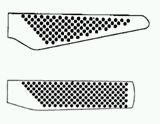In a judgment of 6 March 2014 in joined cases C-337/12 P to C-340/12 P, the Court of Justice of the European Union (the "ECJ") offered guidance on whether the technical effects caused by using a 2D figurative trade mark as a 3D shape should be considered when assessing absolute grounds for refusal of the figurative trade mark.
On 3 and 5 November 1999, Japanese company Yoshida Metal Industry Co. Ltd ("Yoshida") filed two applications to register Community trade marks with OHIM for goods in classes 8 and 21 of the Nice Agreement (cutlery, knives, forks, spoons, knife steels, household or kitchen utensils, etc.). The trade marks for which registration was sought are the signs reproduced below:

After the trade marks had been registered, Pi-Design and Bodum applied for those trade marks to be declared invalid in view of the absolute grounds for refusal under Article 7(1)(e)(ii) of Regulation n° 40/94 of 20 December 1993 on the Community trademark (the "CTM Regulation"). In particular, the claimants argued that Yoshida's trade marks consisted of a shape necessary to obtain a technical result. Indeed, the claimants maintained that the signs represent the handles of Yoshida's typical knives, many of which bear concave dots to prevent the knife handle from slipping.
Yoshida contested those arguments, alleging that the "technical function" ground for refusal could not apply to two-dimensional signs such as its trade mark and that the examination should be limited to the signs as they appear on the registration certificates, i.e. a geometrical shape around a set of black dots.
The cancellation was brought in three separate, but similar proceedings. While the Cancellation Division of OHIM rejected the invalidation claims, the First Board of Appeal of OHIM (the "Board of Appeal") overturned the judgments, thus invalidating Yoshida's trade marks.
First, it found that the classification of a sign as figurative does not necessarily preclude the application of Article 7(1)(e)(ii). Second, the Board of Appeal considered that the black dots represented dents necessary to perform a technical function, i.e. to obtain a non-skid effect.
Yoshida then sought annulment of the Board of Appeal's decisions before the General Court of the European Union (the "General Court").
Although the General Court agreed with the Board of Appeal that the technical function argument applies to all trade marks (irrespective of whether the trade marks are two- or three-dimensional), it considered that the Board of Appeal went too far in concluding that the black dots on the sign were concave. The General Court held that the essential characteristics of the signs must be assessed solely by a visual analysis of those signs as filed, and considered that nothing in the graphic representation of the contested trade mark as filed and registered suggests that the black dots in question represent dents rather than a figurative pattern.
Pi-Design and Bodum further appealed against the General Court's judgment to the ECJ, alleging, in particular, that the General Court had erred in law by holding that the essential characteristics of the signs at issue were to be assessed solely by a visual analysis of those signs as filed. Yoshida, for its part, reiterated its argument that Article 7(1)(e)(ii) of the CTM Regulation does not apply to the case at hand since its trademarks are "purely figurative and two-dimensional designs of staggered black dots", which prevents the application of "technical function" grounds of refusal.
In its judgment of 6 March 2014, the ECJ first recalled that Article 7(1) (e)(ii) of the CTM Regulation must be interpreted in the light of the public interest underlying that ground for refusal, namely that trademark law should not grant a business a monopoly on technical solutions or functional characteristics of a product. Given this public interest and given the wording of Article 7(1)(e)(ii), the ECJ held that this Article rules out the registration of any sign, whether two- or three-dimensional, whose essential characteristics perform a technical function.
The ECJ also held that the General Court erred in considering that a trade mark examination should be limited to the sign as reproduced in the registration application without considering the actual use made of the trade mark following its registration, i.e. the use of the sign on Yoshida's knife products. In this regard, the ECJ held that any information dating after the filing can be taken into account by examiners and courts insofar as it enables conclusions to be drawn with regard to the scope of the trade mark on the filing date.
The ECJ thus set aside the General Court's judgments and remitted the case to the General Court.
The ECJ judgment will prevent trade mark applicants from registering 2D figures in an attempt to protect the 3D shape that may otherwise falter on an absolute ground for refusal. In addition, the freedom to consider the use of the trade mark after the date of the trade mark application for assessing cancellation claims is also likely to have an impact beyond these specific cases. It will be interesting to see how examiners and courts will deal with the large investigative and interpretational freedom thus granted by the ECJ for the assessment of trade mark characteristics and validity on absolute grounds of refusal.
The content of this article is intended to provide a general guide to the subject matter. Specialist advice should be sought about your specific circumstances.
